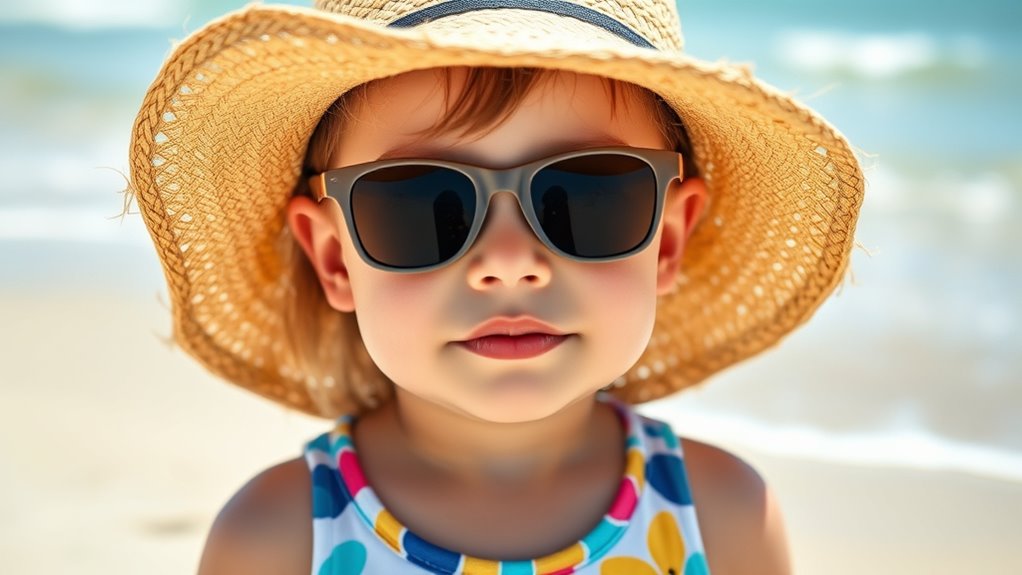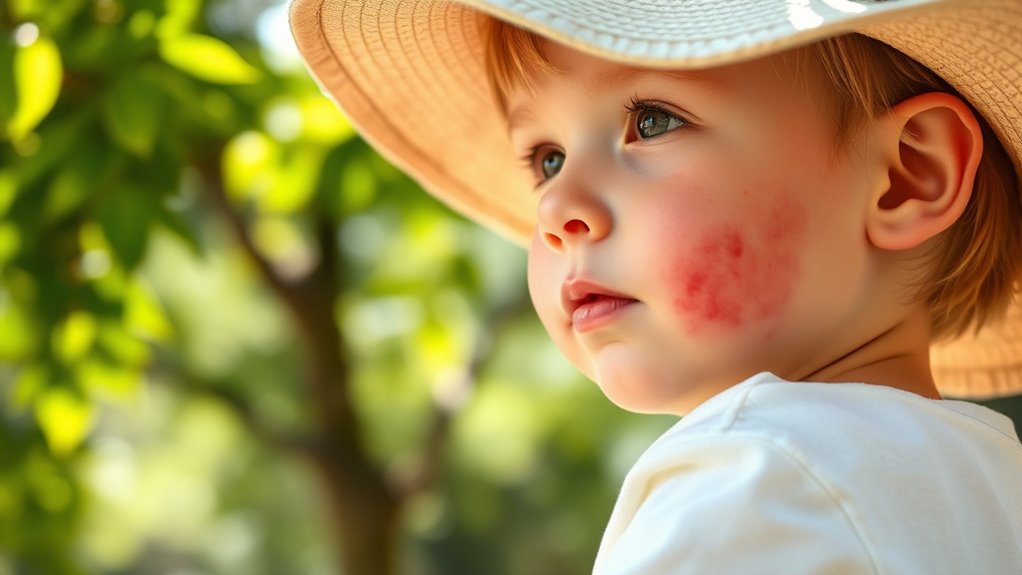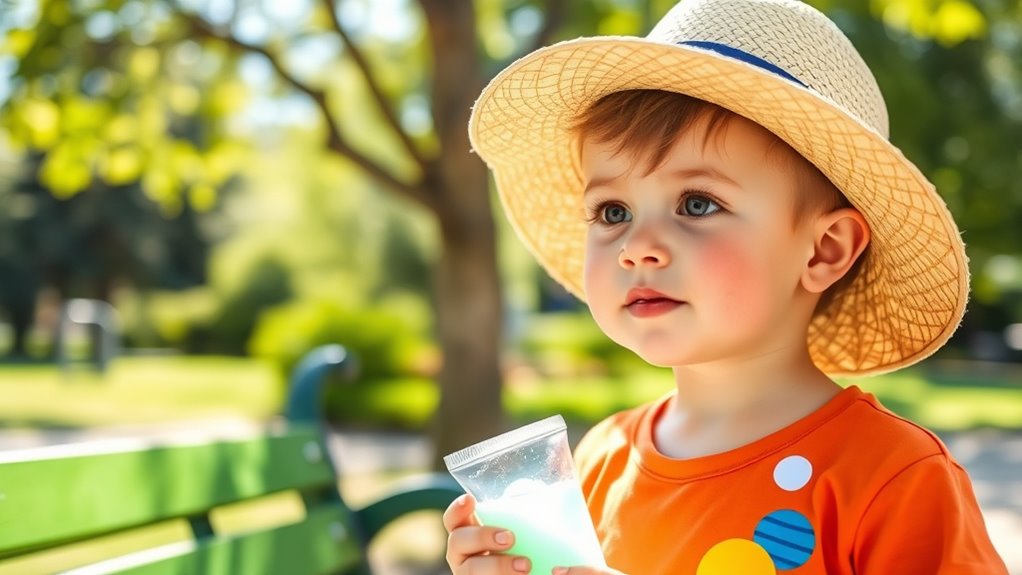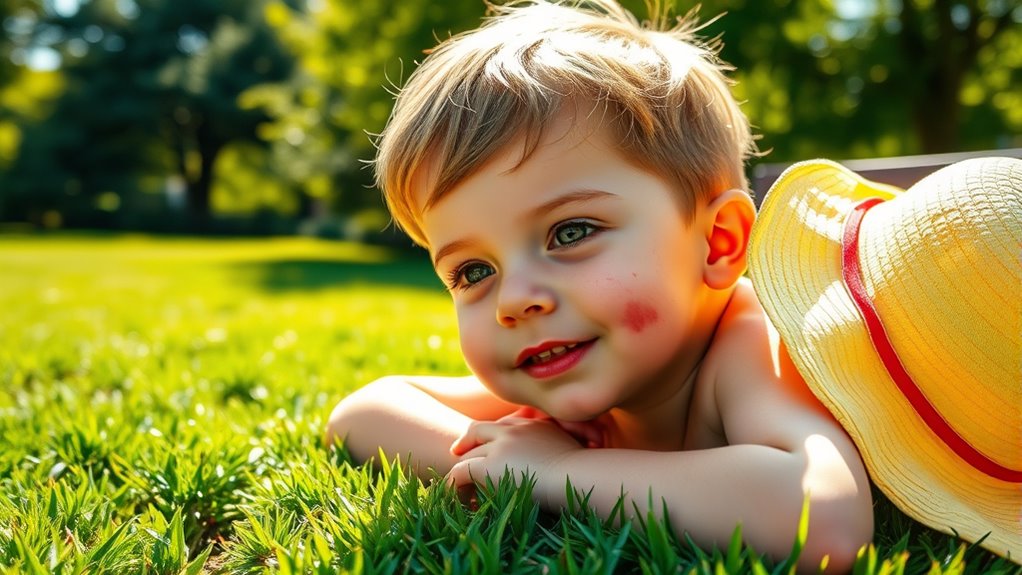To prevent sunburn in children, keep them in shade during peak hours, dress them in UPF-protective clothing, and apply water-resistant sunscreen SPF 30+ generously 15–30 minutes before outdoor activities, reapplying every two hours or after swimming or sweating. For infants under six months, avoid sunscreen and prioritize shade and protective clothing. If a sunburn occurs, use cool compresses, hydrate, and consider pain relievers. Learn more about how to protect your child’s skin long-term and treat sunburn effectively.
Key Takeaways
- Prevent sunburn by applying broad-spectrum SPF 30+ sunscreen and dressing children in UPF clothing and hats.
- Schedule outdoor activities outside peak UV hours, such as early mornings or late afternoons.
- Use shade and protective clothing instead of sunscreen for infants under six months.
- Treat sunburn with cool compresses, pain relievers, and monitor for blisters or systemic symptoms.
- Seek medical attention for severe burns, blisters, or signs of heat illness.
Understanding the Risk Factors for Childhood Sunburn

Understanding the risk factors for childhood sunburn is essential for protecting children’s skin. If your child has fair skin, light hair, or light eyes, they’re more vulnerable because of lower melanin levels, which provide less natural UV protection. Their thinner skin and developing immune system also make them more susceptible to damage. Infants under six months have especially delicate skin and should avoid direct sunlight altogether. Children who spend time outdoors in sunny, high-altitude, or warm environments face increased risks due to higher UV intensity. Additionally, inconsistent sun protection during outdoor play, especially during peak UV hours, heightens the chance of burns. Repeated sun exposure without proper safeguards can lead to long-term skin issues, including a higher risk of melanoma later in life. Incorporating sound vibrations from sound therapy has been studied for its potential to promote skin healing and reduce inflammation, which may be beneficial in sunburn treatment. Recognizing behavioral patterns that increase sun exposure, such as outdoor activities during midday, can also help in designing effective prevention strategies. Being aware of UV index levels in your area can further guide protective measures for children. Furthermore, understanding the melanin levels in skin can help identify children who are at greater risk and need extra precautions. Regularly monitoring skin response to sun exposure can also aid in early detection of potential sun damage and prevent severe burns.
Effective Strategies to Prevent Sunburn in Youngsters

To effectively prevent sunburn in youngsters, it’s essential to manage their outdoor exposure carefully. Limit outdoor activities during peak UV hours, usually between 10 a.m. and 4 p.m., when the sun’s rays are strongest. Plan playtimes in early mornings or late afternoons, and encourage frequent breaks in shaded areas. Avoid extended exposure near reflective surfaces like water, snow, or sand, which intensify UV reflection. Promote playing and resting under natural shade such as trees or man-made structures like umbrellas and canopies. Position outdoor equipment in shaded spots to minimize direct sun. Use portable shade devices when needed. Regularly assess shade options for effectiveness. Monitoring sun safety practices can further reduce the risk of sunburn in children, especially when considering UV reflection factors that can increase sun exposure. Incorporating water reflection awareness into outdoor planning can also help protect sensitive skin from additional UV exposure, emphasizing the importance of understanding outdoor environment conditions to optimize protection. Additionally, choosing clothing made from UV-protective fabrics can provide an extra layer of defense against harmful rays.
Appropriate Use of Sunscreen and Protective Clothing

Using sunscreen and protective clothing together is the most effective way to shield children from harmful UV rays. Apply sunscreen 15-30 minutes before outdoor activities to guarantee proper absorption. Reapply every two hours, or immediately after swimming or sweating, to maintain protection. Choose pediatric-friendly sunscreens formulated for sensitive skin, and use physical sunscreens that reflect UV rays or chemical ones that absorb them. Cover exposed skin with UPF 50+ clothing, such as rash guards, hats, and full-coverage outfits, which reduce the need for frequent reapplication. Ensure clothing is lightweight, breathable, and easy to wash. Combining both methods minimizes missed spots and offers thorough protection. This holistic approach gives you confidence that your child is safe from sun damage while enjoying outdoor activities.
Special Considerations for Infants and Young Children

Children’s sun protection needs change as they grow, especially during infancy when their skin is particularly delicate. Infants have thinner skin, making them more vulnerable to sun damage and quick sunburn development. They’re also more prone to irritation from sunscreen ingredients, so careful product selection is essential. Even indirect sunlight can cause heat stroke and skin damage in babies under 6 months, so strict sun avoidance is necessary. Protecting infants involves minimizing exposure by keeping them in the shade, dressing them in lightweight, covering clothing, and using hats with brims. Sunscreen isn’t recommended for babies under 6 months; instead, focus on physical barriers like shade, clothing, and stroller canopies. Always prioritize their delicate skin and avoid unnecessary sun exposure to prevent long-term damage. Understanding skin sensitivity is crucial for making safe sun protection choices for infants. Additionally, proper awareness of lifestyle factors can help caregivers implement effective sun safety routines for young children. Being mindful of environmental conditions such as reflective surfaces and air quality can further enhance their protection from harmful UV rays. Recognizing advanced sun protection methods can also contribute to more comprehensive care for vulnerable infants.
Recognizing and Managing Immediate Sunburn Symptoms

Recognizing immediate sunburn symptoms in children can be challenging because signs often develop hours after exposure. You might notice redness and swelling starting around four hours later, peaking at 24 hours. Pain can intensify, sometimes becoming severe enough to need pain relief. Blisters may form, indicating a second-degree burn; keep them intact to prevent infection. Watch for systemic symptoms like fever, chills, or weakness, which suggest heat stress. Monitoring symptom progression helps differentiate sunburn from other skin issues. Initial treatment includes cool baths or compresses to soothe heat, along with pain relievers like acetaminophen or ibuprofen. Applying aloe vera or moisturizer can ease discomfort, but avoid irritating products. Keep the child out of the sun and seek medical help if blisters enlarge or systemic symptoms worsen. Being aware of skin damage can help in early identification and management of sunburn severity. Additionally, understanding UV protection measures can prevent future injuries. Proper assessment of burn severity is crucial for determining the appropriate treatment approach. Recognizing the importance of proper hydration can also aid in recovery and reduce the risk of heat-related illnesses.
Long-Term Health Implications of Childhood Sunburns

Exposure to sunburns during childhood can have serious long-term health consequences, particularly increasing the risk of skin cancer later in life. Because children’s thinner skin is more vulnerable, each sunburn causes more damage, raising the chances of melanoma and other skin cancers. Research shows that five or more blistering sunburns between ages 15 and 20 can increase melanoma risk by 80%. Every burn adds to cumulative DNA damage, which can lead to mutations and skin changes decades later. Childhood sun damage also accelerates skin aging, causing wrinkles, dark spots, and loss of elasticity early in life. Additionally, UV exposure impairs your skin’s immune defenses, making it harder to repair damage and increasing the likelihood of chronic skin issues and cancer development over time. Recognizing early signs of skin damage can help in taking prompt protective measures and reducing long-term risks. Furthermore, advances in machine learning algorithms are being used to develop better tools for early detection of skin cancer, improving preventive care. Understanding the biological effects of UV radiation can guide more effective sun protection strategies and reduce the cumulative harm caused by sun exposure over a lifetime.
Recommendations From Health Experts for Sun Safety

How can you effectively protect kids from sun damage? First, use a broad-spectrum sunscreen with SPF 30+ on all exposed skin, especially water-resistant formulas during swimming or sweating. Apply thick layers and reapply every two hours or immediately after water exposure or towel drying. Avoid sunscreen on infants under six months; instead, keep them in shade and cover them with protective clothing. Dress your child in UPF-rated clothes, wide-brimmed hats, UV-blocking sunglasses, and lightweight long sleeves during peak hours. Plan outdoor activities before 10 a.m. or after 2 p.m., and seek shade whenever possible, especially when shadows are short. Teach your child about sun safety as part of daily routines, lead by example, and monitor UV indices regularly for ideal protection. Incorporating shower best practices can help remove sunscreen residues and prevent skin irritation after outdoor activities. Additionally, using proper clothing designed for sun protection can greatly reduce the risk of sunburn and long-term skin damage.
Frequently Asked Questions
How Can I Tell if My Child’s Sunburn Is Severe?
You can tell if your child’s sunburn is severe by checking for intense redness, swelling, and blisters. If your child complains of severe pain, develops a fever, nausea, chills, or feels weak, these are signs of a serious burn. Symptoms usually peak after 24-36 hours and last several days. If you’re worried or notice systemic symptoms, it’s best to seek medical advice promptly to guarantee proper care.
Are There Natural Remedies Effective for Treating Sunburn?
Natural remedies can effectively soothe sunburn symptoms. You should apply pure aloe vera gel directly from the plant or a product without additives to calm inflamed skin. Using cold compresses or taking cool baths with oatmeal or baking soda can also provide relief. Remember to keep your child’s skin moisturized, avoid further sun exposure, and encourage hydration. These simple remedies help reduce redness, pain, and promote healing naturally.
What Are the Signs of Sun Poisoning in Children?
You want to recognize sun poisoning in children, so watch for signs like reddened, swollen skin, and blisters, especially on the shoulders, face, or head. Watch for systemic symptoms such as fever, chills, nausea, headaches, or confusion. Persistent pain, rash, and signs of dehydration, like dizziness or fatigue, are warning signs. If these appear, seek medical help promptly to prevent serious complications and guarantee proper treatment.
How Does Sun Exposure Affect Children With Sensitive Skin?
Think of your child’s skin as a delicate garden needing extra care. When exposed to the sun, children with sensitive skin are more prone to reactions like rashes, swelling, or intense itching. Their immune systems overreact, similar to a firework display gone awry. To protect them, make certain they wear protective clothing, use broad-spectrum sunscreen, and seek shade during peak hours. This way, you help prevent discomfort and skin damage.
Can Repeated Sunburns Cause Long-Term Skin Pigmentation Changes?
Repeated sunburns can definitely cause long-term skin pigmentation changes. When you get sunburned multiple times, UV radiation triggers melanocyte activation and inflammation, leading to post-inflammatory hyperpigmentation. Over time, this damage disrupts skin repair, causing uneven pigmentation and texture changes. To prevent these effects, you should consistently use sunscreen, seek shade, and wear protective clothing, especially to minimize long-term pigmentation issues from repeated sun exposure.
Conclusion
To keep your kids safe from sunburn, stay vigilant and follow these tips like a shield of armor. Protect their skin as if you’re wrapping them in a cozy blanket on a sunny day, preventing painful burns and long-term damage. By being proactive, you guarantee their childhood memories are filled with sunny days, not sunburns. Remember, your careful precautions are the umbrella that keeps them safe in the storm of summer rays.









